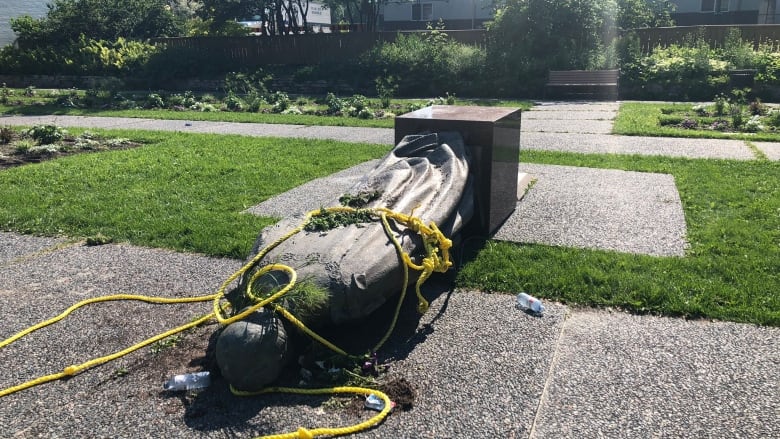With death of Queen Elizabeth, Indigenous people reflect on often difficult relationship with the Crown
'Still hope there that the Crown will build on that relationship' under King Charles: Indigenous studies prof

Whilemany mourn the death of Queen Elizabeth, some First Nations people have expressed ambivalence or animosity towardthe monarchy that colonized North America.
Chance Paupanekis, a Swampy Cree man from Treaty 5 territory, which includes northern Manitoba, views theQueen as part of an ominous institution thatperpetuated harm against Indigenous people.
Upon hearing the news Thursday of her death, Paupanekis thought of the long life the 96-year-old monarchlived, "unlike many of the people who she caused harm to."
"At a surface, [she] seems sweet and kind, but realistically, [she] and her predecessors are responsible for a huge aspect of the genocide of Indigenous peoples across the world," he told CBC's Up To Speed on Friday.
Indigenous people have a relationship with the Crown that dates back to their first contact with Europeans. Through the signing of treaties, the Crown and Indigenous people established terms for how the two sovereign nations would coexist peacefully while sharing the land.
Paupanekis recognizes that happened long before Queen Elizabeth became the monarch but it doesn't change how he feels about the monarchy as a whole.
"The ongoing settler colonial agenda will continue irrespective of which monarch is in charge," he said.
Charles, the Queen's eldest son, was officially proclaimed King on Saturday.
Paupanekis hopes that King Charles III begins the process of giving reparations "not only for First Nation people, but all of the people across the world who the monarch stole from."
Six Nations of the Grand River (Ontario) Chief Mark Hill recognizes the importance of the relationship with the Crown, but like Paupanekis, is still critical of Queen Elizabeth's reign.
"Her legacy with Indigenous people isn't the strongest, and I think that's where I've had difficulty," he said.
"I send my most sincere condolences to the family and the monarchy. However, it's about the next seven generations, and the future, and how we're going to progress," Hill said.
Importance of relationship with the Crown
Niigaan Sinclair says that in homes in northern Manitoba First Nations, it's not uncommon to see photos of Queen Elizabeth, or copies of Hello! a magazine that specializes in coverage ofthe Royal Family which is indicative of how important the relationship with the Crown is.
Indigenous people"share relationships with the Crown, not the Canadian government," said Sinclair, an Indigenous studies professor at the University of Manitoba and thedepartment's acting head.
The treaties were agreed upon by Indigenous leaders and the Crown, not the government of the day, he said, adding that without the Crown, all Canadian lands would revert to Indigenous ownership.

In its infancy, the relationship between Indigenous people andthe Crown held a great dealof promise and opportunity, Sinclair said.
He acknowledges the harm caused by the Crown, including during Queen Elizabeth's 70-year reign. That reign included decades where the residential school system operated in Canada. The last school didn't close until 1997.
But to him, historic government appointments like that of Mary Simon, the Inuk who became Canada's first IndigenousGovernor General last year, show that there is interest in maintaining and working on the relationship.
"There's still hope there that the Crown will build on that relationship," Sinclair said.
Belinda Vandenbroeck attended a residential school in Dauphin, Man., for 10 years.On Canada Day last year, she was at the Manitoba Legislature grounds to give a speech in reaction to the discovery ofwhat are believed to be unmarkedgraves atresidential school sites.
That day, statues of Queen Elizabeth and Queen Victoria at the legislature grounds were toppledin response to the discovery.
As a residential school survivor, she wonders why Queen Elizabeth did not intervene when childrenlike herwere being taken from their families.
She says that if the relationship between Indigenous people and the Crown was more equal, she might feel differently about the institution.
"When you take, take, take, take ... and not give anything in return, it's not a good feeling," Vadenbroeck said.
As prince,Charles has previously spoken of the importance of reconciliation and the need for a renewed relationship with Indigenous people, but it remains to be seen what role he sees for himself in that as King.
With files from Cameron MacIntosh, Simon Dingley and Up To Speed












_(720p).jpg)


 OFFICIAL HD MUSIC VIDEO.jpg)
.jpg)



























































































